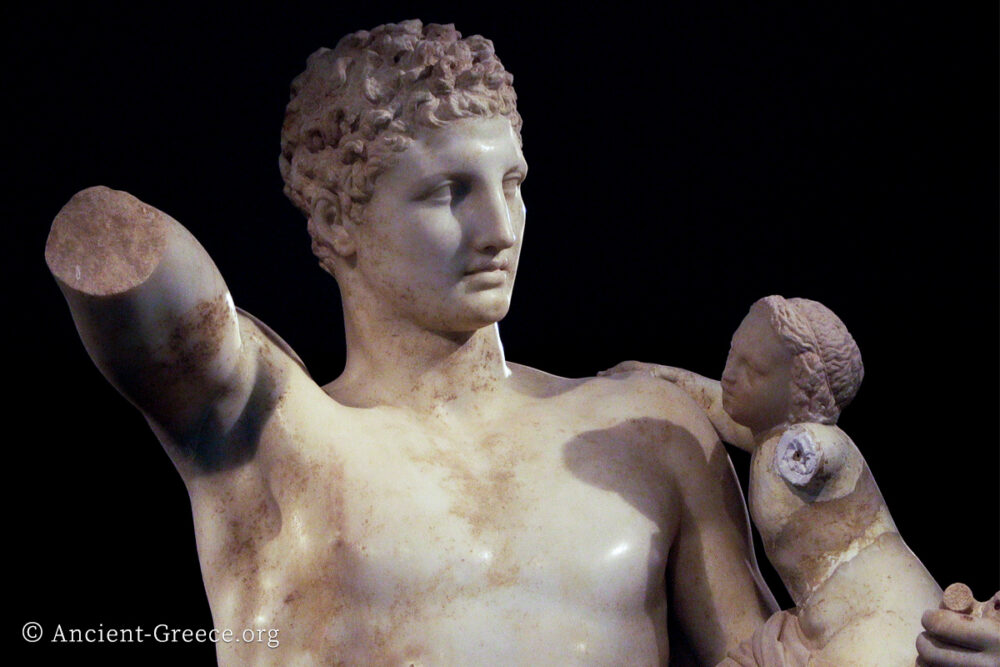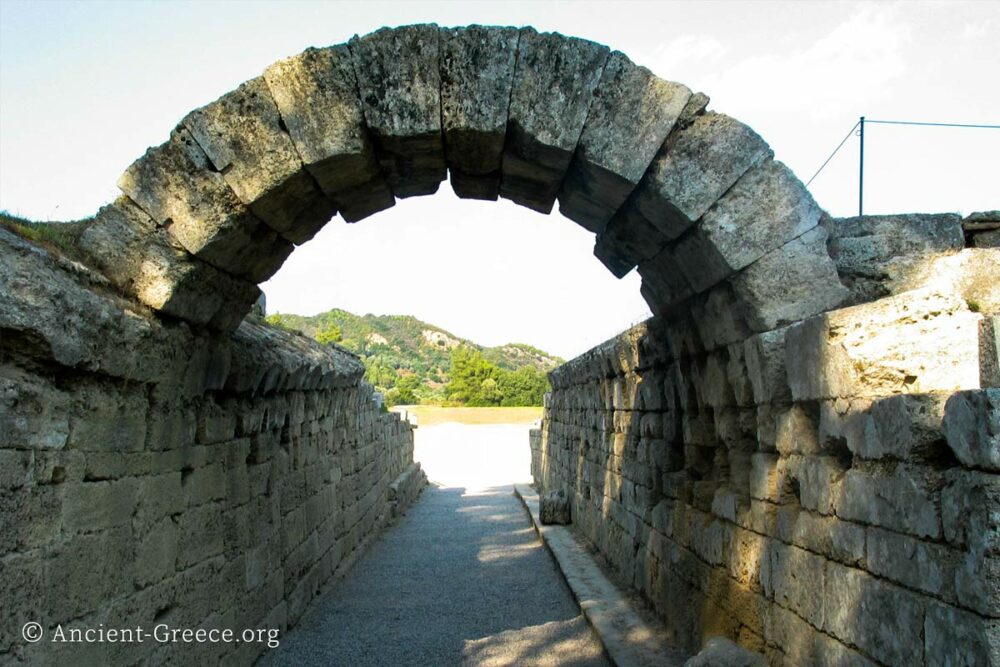
On this page:
The Archaeological Museum of Olympia (Αρχαιολογικό Μουσείο Ολυμπίας) is one of the most visited museums in Greece. It is located in Olympia, Peloponnese, which is one of the most important archaeological sites and the birth of the original Olympic Games.
By the time Theodosius I banned the Olympics and ordered the destruction of the temples, the sanctuary of Olympia had amassed an incredible amount of buildings, fountains, baths, statues, trophies, and votive offerings of every kind.
Even though Olympia was plundered several times in antiquity, plenty of important artifacts remained for archaeologists to unearth. Excavations started in 1875 and continue to our day.
The Museum at Olympia shelters and exhibits the most striking of these finds from the Bronze Age, all the way to Roman and Byzantine times.
Highlights are the sculptures from the temple of Zeus (Pediment and Metopes) from the early classical era, and the superb statue of Hermes of Praxiteles from the late classiclal period.
Hermes of Praxiteles
Perhaps the most renown of all the statues in the Olympia Museum is Hermes of Praxiteles. Marble, Circa 340 BCE.
Hermes is holding the infant Dionysus in his left arm, while he dangles a bunch of grapes in his right (missing) one. It is a typical pose that was reproduced almost identically in many ancient statues, but the original one was attributed to Praxiteles.
The marble is beautifully carved to describe the anatomy of the body in accurate forms, while the treatment of the surface juxtaposing sheen and texture reveal the different roles of the stone: skin, cloth, tree, and hair.
Hermes has assumed the contrapposto pose, typical of Classical standing figures, in an effortless and natural way–his hip pushed upward on the right side to support the entire weight of his body.
Temple of Zeus West Pediment
The Temple of Zeus’ West pediment (circa 460 BCE) arrangement of sculptures contrasts the serenity of the East pediment with a much more dynamic composition that illustrates the fight between Centaurs and Lapiths who are engaged in a battle over the abduction of the Lapith women.
Apollo presides over all in the center flanked by the heroes Theseus and Peirithoos. The figures at the ends were destroyed in 460 BCE and they were replaced at a later date with the ones found in excavations.
Left to right:
- Apollo presiding over the scene.
- Young Lapith fighting with a Centaur who is biting his arm. The Classical era stylistic convention where civilized men show no facial expression and the barbarians are shown in grotesque facial appearance is vividly visible in this group.
- Deidameia repelling the Centaur Eurythion. The fragments on the right are the remnants of the statue of Peirithoos who is about to strike the Centaur to save his young bride from his brutality. Note the austere facial expression of Deidameaia, typical of the period’s idealism where “civilized” humans depicted as if they are always in control of their emotions, as opposed to the beasts that are unable to achieve this level.
- A beautiful composition of movement and rhythm is unfolding through the struggle of the young woman trying to escape a kneeling centaur with the help of another Lapith. The twisting pleats of her peplos is reminiscent of the movement of waves.
- Detail of the previous photo.
Some of these photos depict the sculptures from an angle below, closer to the way they were meant to be seen by viewers as they looked up at the temple’s metopes high above the epistyle (architrave).
Temple of Zeus East Pediment
The Temple of Zeus’ East pediment (circa 460 BCE) depicts the chariot race between Oinomaos and Pelops. They appear in the moments before the race, in a calm and ordered composition.
In the center of the group, Zeus is the ultimate observer is flanked by the two heroes and their wives. Next to them are their horses and chariots (now lost) and several auxiliary figures.
The reclining figures at the two ends of the pediment represent the two rivers of Olympia, Alpheios and Kladeos.
Left to right:
- The ruined statue of Zeus from the center of the East pediment grouping.
- Statue of Oinomaos.
- One of the chariot attendants from the East pediment.
- Figure of the old diviner from the temple of Zeus East pediment. The intense facial expression is unique for this early period of classical art.
- One of the figures from the West pediment of the temple of Zeus. It is a later addition to replace the original statue that was destroyed for unknown reasons in 460 BCE.
The Temple of Zeus Metopes
The temple of Zeus metopes (circa 460 BCE) appeared on the east and west facades, and depict the labors of Heracles.
Many of the sculptures were found severely damaged, but some survived with enough detail to reveal masterful compositions of figure groups in relief. They were carved in Parian marble in 470-457 BCE.
Left to right:
- The 7th metope from the west facade of the temple of Zeus depicts Heracles arresting the Cretan Bull. It is a striking composition with dominant diagonal lines that bestow a wild sense of action to the scene.
- Metope from the east side of the temple of Zeus. It depicts Heracles cleaning the stables of Augean. The goddess Athena points with hand hand at the spot where he should strike to create an opening at the foundations of the stable.
- Metope from the west side of the temple of Zeus illustrates another Heracles labor, the killing of the Stymphalian Birds. He has just finished the task and presents Athena with the lifeless birds (have not survived). The goddess is seated on a rock barefoot. The heads of the two figures are plaster replicas that replace the original parts that are in the Louvre museum in Paris (along with Heracles’ right arm).
- A metope from the east side of the temple of Zeus depicts Heracles performing his Golden Apples of the Hesperides labor. Athena stands behind the hero, helping him support the enormous weight of the sky which rests on his shoulders. A cushion helps him endure the task. Atlas on the right has just returned and presents the apples he fetched for him.
Top row, left to right:
- Relief sculpture depicting Herakles Kills with the Nemean Lion.
- Herakles fighting with the Lernean Hydra. Olympia, Temple of Zeus metope.
- Herakles taming the Keryneian Hind
- Herakles Killing the Amazon Queen Hippolyte
- Herakles with one of the Mares of Diomedes
- Herakles with the Erymanthian Boar
- Herakles and Kerberos
- Herakles Killing Geryon
Some of the photos above depict the sculptures
from an angle below, closer to the way they were meant to be seen by viewers as they looked up at the temple’s metopes high above the epistyle (architrave).
The Nike of Paionios
The Nike of Paionios of Mende in Chalkidiki, Macedonia (his name is carved on the base of the statue). 424 BCE.
The statue of Nike (νίκη, victory) was dedicated by the Messenians and Naupaktians to commemorate their victory over the Lakedaimonians. It stood on a tall pedestal in front of the Temple of Zeus’ east facade.
The statue, even in its ruinous state reveals a strong sense of movement emphasized by the strong diagonal pose (side view), the hovering feet, and the lines of the himation that push against her body as if forced by the wind. Her spread wings and the face have not survived.
Votive Offerings
Top row: Three shields. Shield decoration of a Gorgo with serpents, lion’s legs, and a dragon tail 7(left); a shield bronze ornament depicting a gorgoneion with three revolving wings (middle); an unadorned round shield (right).
Bottom row left: The helmet Miltiades dedicated to Zeus at the sanctuary after he led the Athenians in victory at Marathon. The act is inscribed on the helmet itself “ΜΙΛΤΙΑΔΕΣ ΑΝΕΘΕΚΕΝ ΤΟΙ ΔΙΙ” (the name Miltiades is clearly visible in the lower left part of the helmet). 490 BCE.
Bottom Row right: A Persian helmet dedicated to Zeus by the Athenians after their win against the Persians at Marathon. The helmet was part of the battle spoils and it is inscribed “ΔΙΙ ΑΘΕΝΑΙΟΙ ΜΕΔΟΝ ΛΑΒΟΝΤΕΣ” ([Offered to] Zeus from the Athenians who took it from the Medes). 490 BCE.
Megarian Treasury
The restored entablature and pediment from the treasury of the Megarians (left) and detail of a dying giant (right). 6th century BCE.
The sculpture group of the pediment depicts a Gigantomachy (battle between gods and giants). Most of the statues were found in bits and pieces but one giant survived almost intact (image on the right). He is in the process of falling after being wounded by Zeus.
Clay Sculptures
Left: Clay statue of Zeus carrying Ganymedes to immortality. 470 BCE.
Center: Clay head of Athena 490 BCE.
Right: Clay warrior. Early 5th c. BCE
Stone Sculptures
Top left: Colossal female head wearing the polos, a sacred headdress. It might be from the statue of Hera that was situated inside the Archaic Temple of Hera (Heraion), or from an acroterion Sphinx of another building.
Limestone. Circa 600 BCE.
Top middle: Statue of a seating lion.
Top right: Marble head of a woman.
Bronze Artifacts
Left: Bronze Assyrian sheet decorated with hammered scenes divided in four horizontal zones. The top zone depicts a procession of men, the next below shows a female figure flanked by two men, the next zone below represents two men fighting, and the bottom one has horsemen galloping. It was made in the 8th century BCE in an Assyrian workshop.
Middle: Bronze statuette representing a stag attacked by three dogs. 8th c. BCE.
Right: A typical bronze statuette of Zeus throwing a thunderbolt. This particular pose of Zeus was reproduced countless times in crude little statuettes, and it has been found in several sanctuaries throughout Greece. The type was particularly popular in the 5th century BCE.
From left to right:
- Bronze statuette of a youth. It appears in the typical pose of a “diadoumenos”, and it was probably a handle of a utensil. 6th c. BCE
- Head of a griffin. It was part of a votive tripod rim. Bronze. 7th c. BCE.
- The figure made of hammered bronze sheets. It is a rare example of this manufacturing technique which was widely used in the Archaic period before the invention of the lost-wax process that allowed the creation of hollow sculptures. 590-580 BCE.
- Several sculptures of body parts is exhibited in the museum. They were offered by devotees to the gods in hopes of a cure for the afflicted body part. The practice is still alive in Greece where icons of Christ, Panagia, or Saints is covered by little plaques representing body parts that have been offered in exchange for a cure.






























































